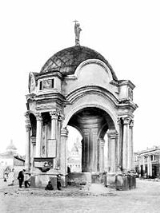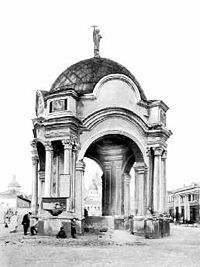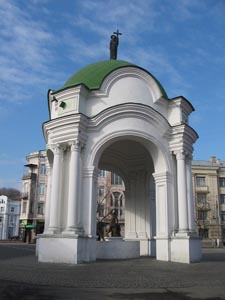
Fountain of Samson, Kiev
Encyclopedia

Romanization of Ukrainian
The romanization or Latinization of Ukrainian is the representation of the Ukrainian language using Latin letters. Ukrainian is natively written in its own Ukrainian alphabet, a variation of Cyrillic....
: Fontan Samson, Felitsiial) is a Ukrainian Baroque
Ukrainian Baroque
Ukrainian Baroque or Cossack Baroque is an architectural style that emerged in Ukraine during the Hetmanate era, in the 17th and 18th centuries....
fountain in the Podil
Podil
The Podil or Podilskyi Raion is a historic neighbourhood and an administrative raion in Kiev, the capital of Ukraine. It is one of the oldest neighborhoods of Kiev, the birthplace of the city's trade, commerce and industry...
raion of Kiev
Kiev
Kiev or Kyiv is the capital and the largest city of Ukraine, located in the north central part of the country on the Dnieper River. The population as of the 2001 census was 2,611,300. However, higher numbers have been cited in the press....
. It was constructed in the 18th Century, later demolished by the Bolsheviks either in 1934 or 1935, and rebuilt in 1981.
History
It was constructed during 1748-1749 after the Podil magistrateMagistrate
A magistrate is an officer of the state; in modern usage the term usually refers to a judge or prosecutor. This was not always the case; in ancient Rome, a magistratus was one of the highest government officers and possessed both judicial and executive powers. Today, in common law systems, a...
's decision to repair the water distribution system. The project was assigned to Ivan Hryhorovych-Barskyi
Ivan Hryhorovych-Barskyi
Ivan Hryhorovych-Barskyi or Ivan Grigorovich-Barsky is a Ukrainian architect who worked in the Late Cossack Baroque style...
, a descendant of a well-known Podil family and a graduate of the Kyiv Mohyla Academy. The fountain was a pavilion-like circular rotunda with a cupola resting on four piers, with each pier embellished by two columns of Corinthian order
Corinthian order
The Corinthian order is one of the three principal classical orders of ancient Greek and Roman architecture. The other two are the Doric and Ionic. When classical architecture was revived during the Renaissance, two more orders were added to the canon, the Tuscan order and the Composite order...
. The dome of the fountain was topped by a 2 meter high gilded copper statue of St. Andrew. Before the 1800s a statue of an angel who held a chance from which water issued and ran into a basin was erected inside the fountain. In 1809, the angel was replaced by an almost life size wooden sculpture of Samson
Samson
Samson, Shimshon ; Shamshoun or Sampson is the third to last of the Judges of the ancient Israelites mentioned in the Tanakh ....
, who was tearing the lion's jaws from which the water flowed, hence the name, Fountain of Samson. The sculpture was likely modeled upon Mikhail Kozlovsky
Mikhail Kozlovsky
Mikhail Ivanovich Kozlovsky was a Russian Neoclassical sculptor active during the Age of Enlightenment....
's famous statue, a centerpiece of the Peterhof Palace
Peterhof Palace
The Peterhof Palace in Russian, so German is transliterated as "Петергoф" Petergof into Russian) for "Peter's Court") is actually a series of palaces and gardens located in Saint Petersburg, Russia, laid out on the orders of Peter the Great. These Palaces and gardens are sometimes referred as the...
Grand Cascade, with St. Samson symbolising the Russian victory over Sweden at Poltava
Battle of Poltava
The Battle of Poltava on 27 June 1709 was the decisive victory of Peter I of Russia over the Swedish forces under Field Marshal Carl Gustav Rehnskiöld in one of the battles of the Great Northern War. It is widely believed to have been the beginning of Sweden's decline as a Great Power; the...
: the lion is an element of Sweden's coat of arms and the battle was won on St. Samson Day. The fountain received its water supply from the Starokievskaya Gora through wooden pipes.

World War I
World War I , which was predominantly called the World War or the Great War from its occurrence until 1939, and the First World War or World War I thereafter, was a major war centred in Europe that began on 28 July 1914 and lasted until 11 November 1918...
the two statues of St. Andrew and Samson were removed from the fountain and put into storage, which later proved beneficial as the Bolsheviks destroyed the structure altogether. In 1927 the rotunda's dome was repaired by the Kiev City Council
Kiev City Council
Kiev City Council or Kyivrada is the city council of Kiev municipality, the highest representative body of the city community. The members of city council are directly elected by Kievans and the council is chaired by the Mayor of Kiev .The council meets in a 1950s City Council building...
government. During 1935, the Architectural Planning Administration proposed to include the structure in a planned park on the Red Square (now the Kontraktova Square
Kontraktova Square
Kontraktova Square or Kontraktovaya Square is a square in the historic Podil neighborhood of Kiev, the capital of Ukraine. The square is an important economic, cultural, and transport center of the Podil, containing numerous architectural and historical monuments.-History:Kontraktova Square is...
). According to a factually uncertain story, Communist Party
Communist party
A political party described as a Communist party includes those that advocate the application of the social principles of communism through a communist form of government...
official Pavel Postyshev
Pavel Postyshev
Pavel Petrovich Postyshev was a Soviet politician. He is considered to be one of the principal architects of the so-called man-made famine of 1932–33, or Holodomor.Postyshev was born in Ivanovo-Voznesensk....
, instructed the Chairman of the City Council, Ryzhkov, to remove the so-called "kiosk". Overnight the 18th century structure was dismantled. Its foundations however were preserved.
During the second half of the 1970s a decision was made to reintroduce the lost historical atmosphere to the old merchant and artisans quarter of Ukrainian capital, as part of an effort to develop the Podil as a tourist center of Kiev. In these plans the rebuilding of the Fountain of Samson was included. In the autumn of 1977, the government of the Ukrainian S.S.R. directed the City Council of Kiev to rebuild the structure, which was finished in 1981. It was built according to designs by Ukrainian architect V. P. Shevehenko. Today the fountain has sundial
Sundial
A sundial is a device that measures time by the position of the Sun. In common designs such as the horizontal sundial, the sun casts a shadow from its style onto a surface marked with lines indicating the hours of the day. The style is the time-telling edge of the gnomon, often a thin rod or a...
clocks on the columns it contains concrete copies of the original statues of St. Andrew and Samson, the originals are on display in the National Art Museum of Ukraine
National Art Museum of Ukraine
The National Art Museum of Ukraine is a museum dedicated to Ukrainian art in Kiev, Ukraine.-Architecture:Constructed in 1898, by architect Vladislav Gorodetsky, the building was originally designed as the museum for the local society of patrons of arts and antique lovers...
.

